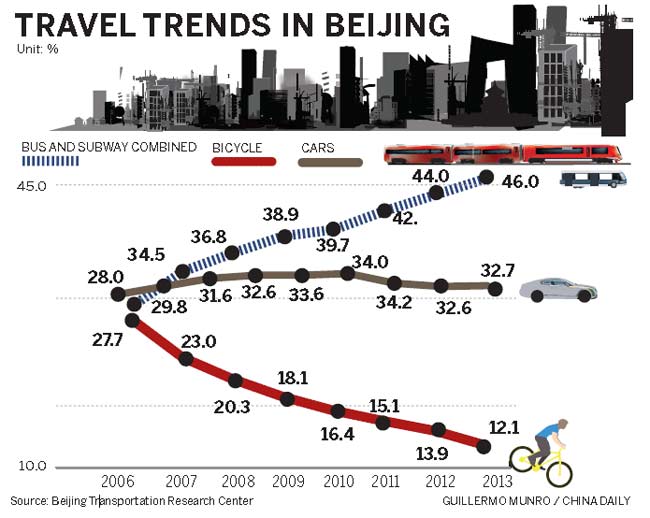

Capital's subways and buses strain to serve its fast-growing population.
Beijing resident Shi Chao leaves home before 7 am and waits for the bus to take him to the subway station.
He then transfers from Line 1 to Line 10, passing 22 stations. The trip takes at least 50 minutes in a packed carriage where he can hardly move.
After that, it is another crowded bus ride in traffic jams before he reaches his office.
Shi's daily commute from his apartment outside the capital's West Fifth Ring Road to his company near the Northeast Fourth Ring Road takes him about two hours covering more than 50 kilometers.
The 28-year-old has been going through the ordeal since 2009, when he arrived in Beijing from his hometown in Shanxi province.
"It's quite common to wait for several subway carriages before I manage to squeeze into a spot on one of them," Shi said.
"Fortunately, I've got used to this daily 'long march'," he said, referring to the historic 10,000-km trek of the Chinese communists in their fight against the Nationalist forces.
Shi is just one of the millions of commuters in the Chinese capital who battle daily with rush hour through a fast-developing but increasingly strained public transport system.
Xu Fang, who lives in Yanjiao at the border area between Beijing and Hebei province, spends about two hours every day taking taxis and the subway to her office in the northeast of the capital, in the opposite direction of her home.
The 30-year-old has been making the trip to her company for the past few days.
But unlike Shi, she has had enough.
"I cannot bear another day like this. I'm moving to a place nearer my office," said the native of Sichuan province.
For Wang Pengfei, an insurance company employee, the many altercations between frustrated passengers on the packed subway have also become routine.
"I nearly suffocated once in the carriage and had to get out halfway to breathe properly," said the 29-year-old, recalling a day in 2011 when there was no air conditioning on the trains.
There have been an increasing number of stories about Beijing's crowded subways and public buses hitting the headlines.
At the Tiantongyuan and Huilongguan subway stations in the north, where residential communities are concentrated, more than 20,000 commuters flooded the stops in two hours, setting a record last November.
Many commuters in January reported spending more than 30 minutes before actually reaching the waiting area for the trains in the stations.
A report from Peking University showed that residents in Beijing spent the longest time commuting, about 1.32 hours a day for work on average in 2012, followed by residents in Shanghai and Tianjin, both traveling about 1.1 hours.
Coping with growth
Beijing, as the country's capital, was the first city to have a subway. Many believe the head start has also developed into the most comprehensive urban public transport network in China.
City authorities started planning for a subway system in 1953 and completed China's first metro Subway Line 1 - in 1969. By the end of 2013, the capital had 17 operating subway lines totaling 462 kilometers (excluding line S2), with 277 stations. Passenger capacity reached 3.2 billion in 2013, statistics from the Beijing Transportation Research Center showed.
Beijing's public bus network has also developed swiftly, making it one of the busiest urban transport systems in the country. By the end of 2013, the city had 785 bus lines, covering both downtown districts as well as suburban areas.
More than 4.63 billion passengers had taken the buses in 2013, based on a report from Beijing Public Transport Holdings, which is in charge of the major operation of the capital's ground public transportation system.
Though the combined annual passenger capacity for public buses has exceeded 7.8 billion, many say that is still not enough to satisfy travel demand. Complains about frequent traffic jams and overcrowded subways and buses continue to be hot topics among residents.
Beijing has also been growing larger with increasing pressure from the population. Its residential population has risen from 13.6 million in 2000 to 21.1 million in 2013. The flood of visitors during holidays has worsened the burden on public transport.
Copyright ©1999-2018
Chinanews.com. All rights reserved.
Reproduction in whole or in part without permission is prohibited.